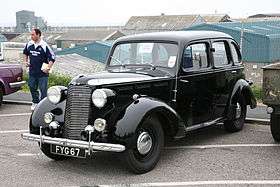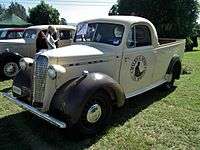Vauxhall 14-6
The Vauxhall 14-6 is an automobile which was produced by Vauxhall in the United Kingdom from 1939 to 1948.[2]
| Vauxhall 14-6 | |
|---|---|
 Vauxhall Fourteen-Six 1938-1948 unitary hulled six-light saloon 1947 example | |
| Overview | |
| Manufacturer | Vauxhall (General Motors) |
| Also called | Vauxhall Fourteen-Six Vauxhall Model J |
| Production | 1939 to 1948 |
| Assembly | United Kingdom Australia |
| Body and chassis | |
| Body style | 4-door saloon 2-door coupé (Australia) 2-door roadster (Australia) |
| Layout | FR layout |
| Related | Bedford JC |
| Powertrain | |
| Engine | 1,781cc I6 |
| Dimensions | |
| Wheelbase | 105 in (2,700 mm) [1] |
| Length | 168 in (4,300 mm) |
| Width | 635 in (16,100 mm) |
| Curb weight | 22.5 cwt |
| Chronology | |
| Predecessor | Vauxhall Light Six |
| Successor | Vauxhall Velox |
Announced in early October[3] for the 1938 Earls Court Motor Show the 14-6 was offered as a six-light, four door saloon [2] and was powered by a four bearing, OHV, 1,781cc Straight-six engine.[4] It had a top speed of 70mph and could accelerate from 0-50mph in 18.2 seconds.[5]
Engine, transmission and suspension
The previous engine was retained but with compression ratio raised from 6.25 to 6.75:1 and revised timing increasing the output to 48bhp at 3000rpm.[5] Other features included independent front suspension using torsion bars in place of the previous Dubonnet system with semi-elliptic leaf springs at the rear, Lockheed hydraulic brakes and a three-speed all-synchromesh gearbox in place of the four-speed "silent third" gearbox.[4]
Unitary chassis-body

serving in France 1940
The car now had a unitary hull which had a 4 in (100 mm) longer wheelbase and 1 in (25 mm) wider track than its predecessor which made it larger than the 12-4 model announced at the same time. Previously the 12 and 14hp models had shared the same body. Interior features included individual leather front seats and a rear seat with fold-down arm rest, a rear window blind and a sliding sunroof.
Post-war models can be distinguished by bonnet-louvre and grille changes.[2]
45,499 examples were produced,[4] including 30,511 in the post-war period.[2]
Australian production, Vauxhall Senior
A Vauxhall 14 J was built by General Motors in Australia without unitary construction[note 1] which was beyond the capacity of local presses but sharing much of the English car's styling.[6][7] The separate chassis allowed the Australian firm to provide open and utility bodies. Commencing in 1939, the 14 was offered in sedan, coupé and roadster body-styles.[6] and as in UK but in a Holden version, a light utility.[note 2]
A 14 sedan was the first civilian car to be produced by GMH in the post-war period, leaving the Fishermans Bend assembly line on 21 May 1946.[6]
 (Holden) drophead coupé 1939
(Holden) drophead coupé 1939 (Holden) Bedford coupé utility 1940 or business roadster
(Holden) Bedford coupé utility 1940 or business roadster- (Model J) 1946
note Holden's divided windscreen and roof
Notes
- "The husky frame has an X-shaped cross-member and the deep side rails . . ." Truth, 4 June 1939
- Four models, a business roadster, sports roadster, convertible coupe and saloon. The Sun
References
| Wikimedia Commons has media related to Vauxhall Fourteen-Six. |
- Norm Darwin, The History of Holden since 1917, Ford Publications Pty Ltd, 1983, pages 87-89
- Michal Sedgwick & Mark Gillies, Vauxhall J-Fourteen-Six, A-Z of Cars 1945-1970, Haymarket Publishing Ltd, 1994, page 212
- Cars Of 1939, Vauxhall 14 changes. The Times, Thursday, Oct 06, 1938; pg. 17; Issue 48118
- Michal Sedgwick & Mark Gillies, Vauxhall J-Fourteen-Six, A-Z of Cars of the 1930s, Haymarket Publishing Ltd, 1993, page 208
- Culshaw; Horrobin (1974). Complete Catalogue of British Cars. London: Macmillan. ISBN 978-0-333-16689-5.
- Norm Darwin, 100 Years of GM in Australia, January 2002, pages 130-133
- Motoring, photograph—Vauxhall 14 Sydney Morning Herald, page 6, 2 May 1939